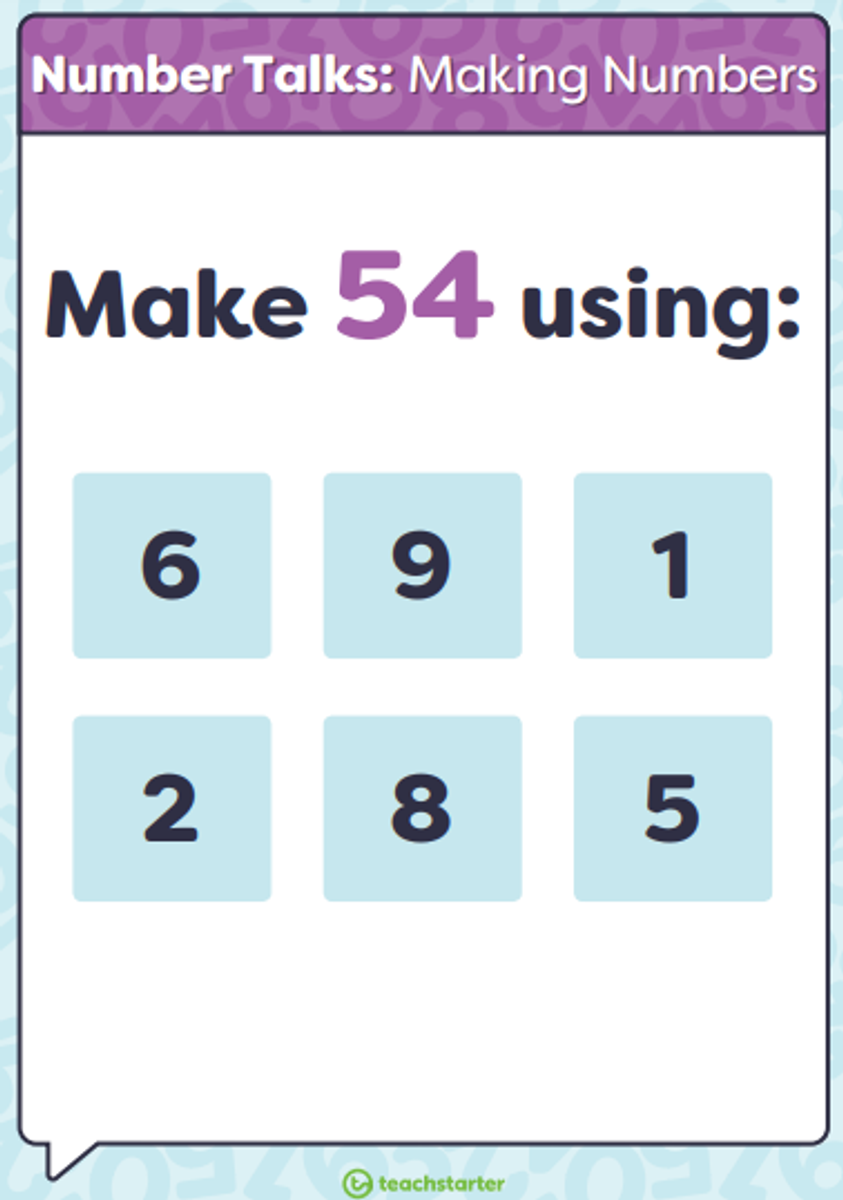Mathematics

In last week’s newsletter we put a spotlight on Mathematics in our junior levels and how a structured inquiry (student centred) approach to learning Mathematics benefited our students’ learning. This week we take a look at Maths Talks and how these are used to ‘launch’ lessons and engage our students.
Maths Talks
Maths Talks are a wonderful way to engage students in Mathematical thinking whilst they develop computational fluency. They are a short (5-10minute) task used to launch Mathematics lessons. Hand Signals are taught to students and used to respond to the image/ task posed. These signals are the same in many countries around the world that use Maths Talks. Students develop oral (Mathematical) language and understanding, whilst reasoning and justifying their responses in a safe environment. Viewing a student's grasp of the Mathematics Proficiencies through Maths Talks is a powerful tool for teachers to observe, assess and plan for.
Some different types of Maths Talks:
Number Talks
Which One Doesn’t Belong
Fraction Talks
Dots Talks
Images/ Pictures
Shape Talks
Pattern Talks
Let’s take a look at Which One Doesn’t Belong. Below are two images that you can try with your family at home. Students and parents are asked to pick one that ‘doesn’t belong’ and justify why this is the case. It’s often very difficult to keep these to 10 minutes as students become so engaged and love sharing their thinking!
After having a go, watch Which One Doesn't Belong and Why which provides reasons why each of the numbers doesn’t belong from the first example above. How did you go?
For more examples on Which One Doesn’t Belong please visit https://wodb.ca/ which has been compiled by Mary Bourassa.
Below are examples of Number Talks that you could do at home with your child, along with prompts to support, challenge and encourage deeper thinking.
Target Number: Pick any number suitable to your child’s year level and show them the number. Then, ask them to come up with number sentences (equations) that equal your number, remembering that Maths Talks are used to practise computational fluency or mental strategies (opposed to written methods). Questions you could ask are as follows:
If we only add 2 numbers, how many answers can we find?
What if we add 3 numbers, or 4 numbers?
What about any number of numbers?
What if we only subtract, or only multiply, or only divide?
What’s the longest number sequence you can find that hits the target number?
Can you hit the target number if you only use a single number, such as the number 4, in your equation?
Dot Talks are another powerful Maths Talk used in Rangeview classrooms loved by our students. We aim to spark curiosity and critical thinking, and Dot Talks are a powerful tool to support this. Our students love them! Some examples are below along with prompts that can be used with students to extend their Mathematical thinking.
To view a Dot Talk in action run by Jo Boaler please watch Dot Talk in Action which also demonstrates how the below prompts are used to support students’ reasoning skills.
How many dots? How do you see them?
Is it like this? Is this what you saw?
Is it a little bit like this other one? What was different about it?
Why did you ______? What did you do after that?
When engaging in Maths Talks with students at Rangeview, teachers:
Use the responses from students to label and record the strategy they have used.
Vary the Maths Talk to suit the needs of students.
Vary the sharing strategies used.
Vary the level of difficulty.
Ensure that the Maths Talk is accessible by ALL students, regardless of where they are in the Mathematics learning. This is often referred to a ‘low floor-high ceiling’ task.
Rangeview Mathematician Award
This initiative began in Term 2 and is awarded to two students from each level at Junior and Senior Assemblies. Congratulations to our Term 3 recipients who are listed below:
Foundation: Rohan (FK) and Sam K (FB)
Level 1: Eloise (1A) and Lewis (1M)
Level 2: Chloe L (2H) and Eric (2A)
Level 3: Leo L (3T) and Scarlet W (3M)
Level 4: Edie W (4H) and Jacob L (4C)
Level 5: Josephine (56G) and Kylie H (56K)
Level 6: Archer (56C) and Sam B (56T)
The Mathematician Award is awarded to students for various reasons including demonstration of a Growth Mindset, amazing reasoning skills, application of a variety of strategies to solve problems, peer to peer mentoring and more!
Brain teaser: Senior School
Billie is really in to sneakers. They bought a pair for $100, aiming to sell them for a profit. First, they put the price up 50% and tried to sell the sneakers. After a few months, they decided to drop the price by 50%, and the sneakers sold.
Did Billie make money, lose money, or sell the sneakers at their original price?
For a hint or to check your answer please visit https://blog.doublehelix.csiro.au/sneaker-discount-brainteaser/.
In our next newsletter we will provide information on the Mathematics Curriculum by Year Level and what concepts are taught. If there is anything specific you would like more information on, please don’t hesitate to contact us via the office or email us via Compass directly.
Go Maths!
Vicki Tzimos and Lee Giddings (34V)







